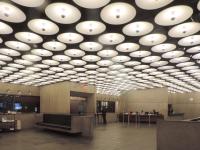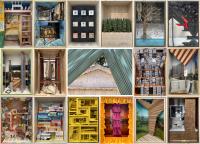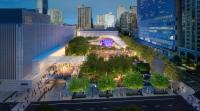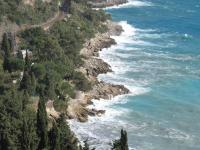VNG - Headquarters, Verbundnetz Gas AG
Leipzig, Germany
Situated in a business park northeast of downtown Leipzig and surrounded by Cold War-era prefab concrete buildings, small garden colony shacks, single-family homes, and now defunct industrial facilities, the elongated building consists of four components: a four-story west bar, a sixstory east bar, an atrium space covered by a sloping glass roof between these two parallel bars, and a computer center beneath the atrium’s cascading stairs.
Whereas the design of the narrow, south side of the building is intentionally unobtrusive, its northern counterpart is clearly highlighted by a prominent glass tower, a flat water basin, and a stairwell clad in aluminum. The reinforced concrete construction transitions into a pure steel construction above the fourth floor on the west side and above the sixth floor on the east. Multiple façade systems were selected for the building envelope: an information filter and climatic membrane, which has a simultaneously vitreous and metallic appearance. For example, on the street side of the building to the east there is a double-skin façade with Venetian blinds, and on the garden side to the west a façade with fixed external solar shades and windows that can be opened.
The atrium assumes the full height of the building and extends across its entire horizontal axis in one long, gentle motion: from the full building height of the glazed northern wall across a cascade of terraces— beneath which lies the protected computer center—up to the restaurant at the southern wall, where the upper terrace leads from the inside onto the exterior roof of the building. In addition to these spaces, the bridges connecting the office wings also provide ample opportunities for informal communication.
Cubicle, team, and group offices are available to the approximately 500 employees working in the building. The average office has a surface area of twenty-four square meters. A metal panel in the doorframe of each office allows for individual adjustments of artificial light intensity, sunshading, heating, and cooling. After hours, a control system secures and adjusts these parameters.
The administrative offices and the computer center are laid out not only with respect to organizational considerations but also energy concerns. Their heating and cooling mechanisms are linked. The power required by the computer center is produced on site by combined heat and power plants. The thermodynamics of the atrium played a major role in determining the form of the building. The flow of air through the space is used to transport cool air in the summer and heat in the winter. Baroque synaesthetics, the dissolution of apparent material, the unity of art and architecture—James Turrell incorporated these into his light installation. On the north side of the building a glazed, threesided
rectangular block protrudes from one of the long office bars. This section of the building is used for conferences. Neon tubes have been integrated into the outer edges of each floor slab. Digital programming allows the neon lights to change color gradually, bathing this part of the building in a range of different chromatic tones.
- Architects
- Eike Becker Architekten
- Location
- Braunstraße 7, Leipzig, Germany
- Year
- 1997









